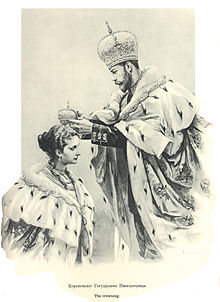
Maria Feodorovna, known before her marriage as Princess Dagmar of Denmark, was Empress of Russia from 1881 to 1894 as the wife of Emperor Alexander III. She was the fourth child and second daughter of Christian IX of Denmark and Louise of Hesse-Kassel. Maria’s eldest son, Nicholas, was the last Emperor of Russia, ruling from 1 November 1894 until his abdication on 15 March 1917. Maria lived for 10 years after Bolshevik functionaries killed Nicholas and his immediate family in 1918.

The House of Romanov was the reigning imperial house of Russia from 1613 to 1917. They achieved prominence after Anastasia Romanovna married Ivan the Terrible, the first crowned tsar of all Russia. Nicholas II and his immediate family were executed in 1918, but there are still living descendants.

Alexandra Feodorovna, Princess Alix of Hesse and by Rhine at birth, was the last Empress of Russia as the consort of Emperor Nicholas II from their marriage on 26 November [O.S. 14 November] 1894 until his forced abdication on 15 March [O.S. 2 March] 1917. A favourite granddaughter of Queen Victoria of the United Kingdom, she was, like her grandmother, one of the most famous royal carriers of haemophilia and bore a haemophiliac heir, Alexei Nikolaevich, Tsarevich of Russia. Her reputation for encouraging her husband's resistance to the surrender of autocratic authority and her known faith in the Russian mystic Grigori Rasputin severely damaged her popularity and that of the Romanov monarchy in its final years. She and her immediate family were all murdered while in Bolshevik captivity in 1918, during the Russian Revolution. In 2000, the Russian Orthodox Church canonized her as Saint Alexandra the Passion Bearer.

Grand Duke Dmitri Pavlovich of Russia was a son of Grand Duke Paul Alexandrovich of Russia, a grandson of Tsar Alexander II of Russia and a first cousin of Tsar Nicholas II, Marie of Edinburgh, King George II of Greece, King Alexander of Greece, King Paul of Greece, and Prince Philip, Duke of Edinburgh.

Grand Duke Kirill Vladimirovich of Russia was a son of Grand Duke Vladimir Alexandrovich of Russia, a grandson of Emperor Alexander II and a first cousin of Nicholas II, Russia's last emperor. He was also the uncle of Princess Marina, Duchess of Kent.

Grand Duchess Maria Vladimirovna of Russia has been a claimant to the headship of the House of Romanov, the Imperial Family of Russia since 1992. She is a great-great-granddaughter in the male line of Emperor Alexander II of Russia. Although she has used Grand Duchess of Russia as her title of pretence with the style Imperial Highness throughout her life, her right to do so is disputed. Since her father's death on April 21, 1992, some of her monarchist supporters have referred to her as Maria I, titular "Empress of Russia", a title she does not claim herself.

Grand Duke Sergei Alexandrovich of Russia was the fifth son and seventh child of Emperor Alexander II of Russia. He was an influential figure during the reigns of his brother Emperor Alexander III of Russia and his nephew Emperor Nicholas II, who was also his brother-in-law through Sergei's marriage to Elisabeth, the sister of Empress Alexandra.
Nicholas Romanovich Romanov was a claimant to the headship of the House of Romanov and president of the Romanov Family Association. Although undoubtedly a descendant of Emperor Nicholas I of Russia, his claimed titles and official membership in the former Imperial House were disputed by those who maintained that his parents' marriage violated the laws of the Russian Empire.
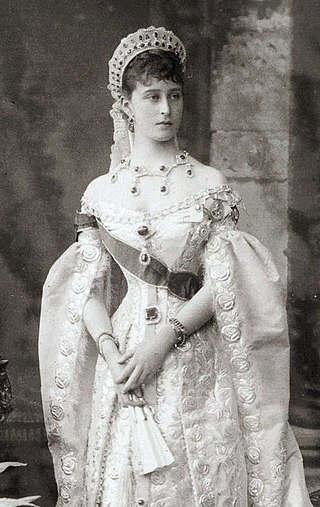
Grand Duchess Elizabeth Feodorovna of Russia was a German Hessian and Rhenish princess of the House of Hesse-Darmstadt, and the wife of Grand Duke Sergei Alexandrovich of Russia, the fifth son of Emperor Alexander II of Russia and Princess Marie of Hesse and by Rhine.

Grand Duke Paul Alexandrovich of Russia was the sixth son and youngest child of Emperor Alexander II of Russia by his first wife, Empress Maria Alexandrovna. He was a brother of Emperor Alexander III and uncle of Nicholas II, Russia's last monarch.
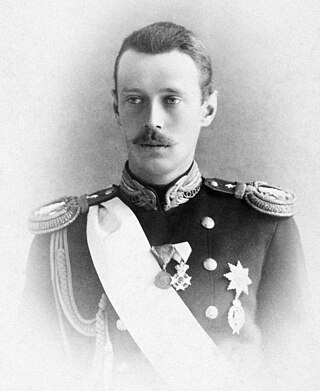
Grand Duke George Alexandrovich of Russia was the third son of Emperor Alexander III and Empress Maria of Russia and brother of Emperor Nicholas II.

Princess Irene of Hesse and by Rhine, later Princess Henry of Prussia, was the third child and third daughter of Princess Alice of the United Kingdom and Louis IV, Grand Duke of Hesse and by Rhine. Her maternal grandparents were Queen Victoria and Prince Albert of Saxe-Coburg and Gotha. Her paternal grandparents were Prince Charles of Hesse and by Rhine and Princess Elisabeth of Prussia. She was the wife of Prince Henry of Prussia, a younger brother of Wilhelm II, German Emperor and her first cousin. The SS Prinzessin Irene, a liner of the North German Lloyd was named after her.
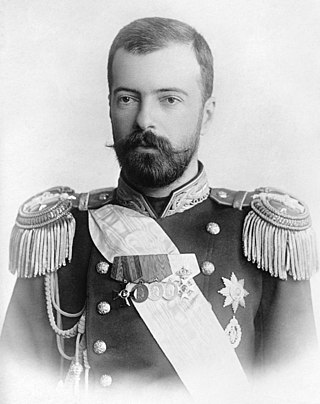
Grand Duke Alexander Mikhailovich of Russia was an Imperial Grand Duke and dynast of the House of Romanov of the Russian Empire, a naval officer, an author, explorer, the brother-in-law of Emperor Nicholas II and advisor to him.

Princess Juliane of Saxe-Coburg-Saalfeld, also known as Grand Duchess Anna Feodorovna of Russia, was a German princess of the ducal house of Saxe-Coburg-Saalfeld who became the wife of Grand Duke Konstantin Pavlovich of Russia.
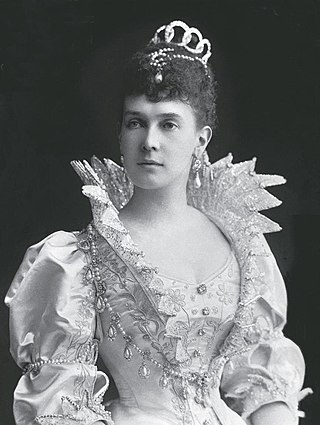
Duchess Marie of Mecklenburg-Schwerin, later Grand Duchess Maria Pavlovna, Grand Duchess Vladimir "Miechen" of Russia, also known as Maria Pavlovna the Elder, was the eldest daughter of Grand Duke Friedrich Franz II of Mecklenburg-Schwerin by his first wife, Princess Augusta Reuss of Köstritz. A prominent hostess in Saint Petersburg following her marriage in 1874 to the Grand Duke Vladimir Alexandrovich of Russia, she was known by many as the "grandest of the grand duchesses".
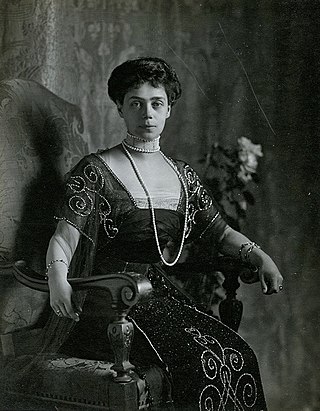
Grand Duchess Xenia Alexandrovna of Russia was the elder daughter and fourth child of Tsar Alexander III of Russia and Empress Maria Feodorovna of Russia and the sister of Emperor Nicholas II.

Prince Andrei Alexandrovich of Russia was the first son and second child of Grand Duke Alexander Mikhailovich of Russia and Grand Duchess Xenia Alexandrovna of Russia. He was also the eldest nephew of Nicholas II of Russia, the last Tsar.

Prince Vasili Alexandrovich of Russia was the sixth son and youngest child of Grand Duke Alexander Mikhailovich of Russia and Grand Duchess Xenia Alexandrovna of Russia. He was a nephew of Tsar Nicholas II of Russia.
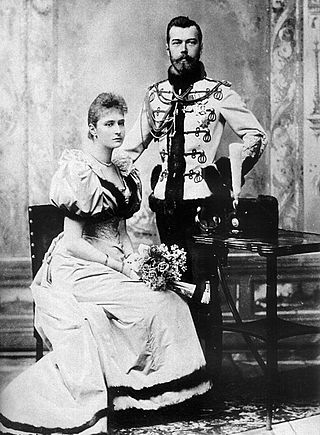
The wedding of Nicholas II of Russia to Alexandra Feodorovna occurred on 26 November [O.S. 14 November] 1894 at the Grand Church of the Winter Palace.

The coronation of George V and his wife, Mary, as king and queen of the United Kingdom and the British Dominions took place at Westminster Abbey, London, on Thursday 22 June 1911. This was the second of four such events held during the 20th century and the last to be attended by royal representatives of the great continental European empires.





